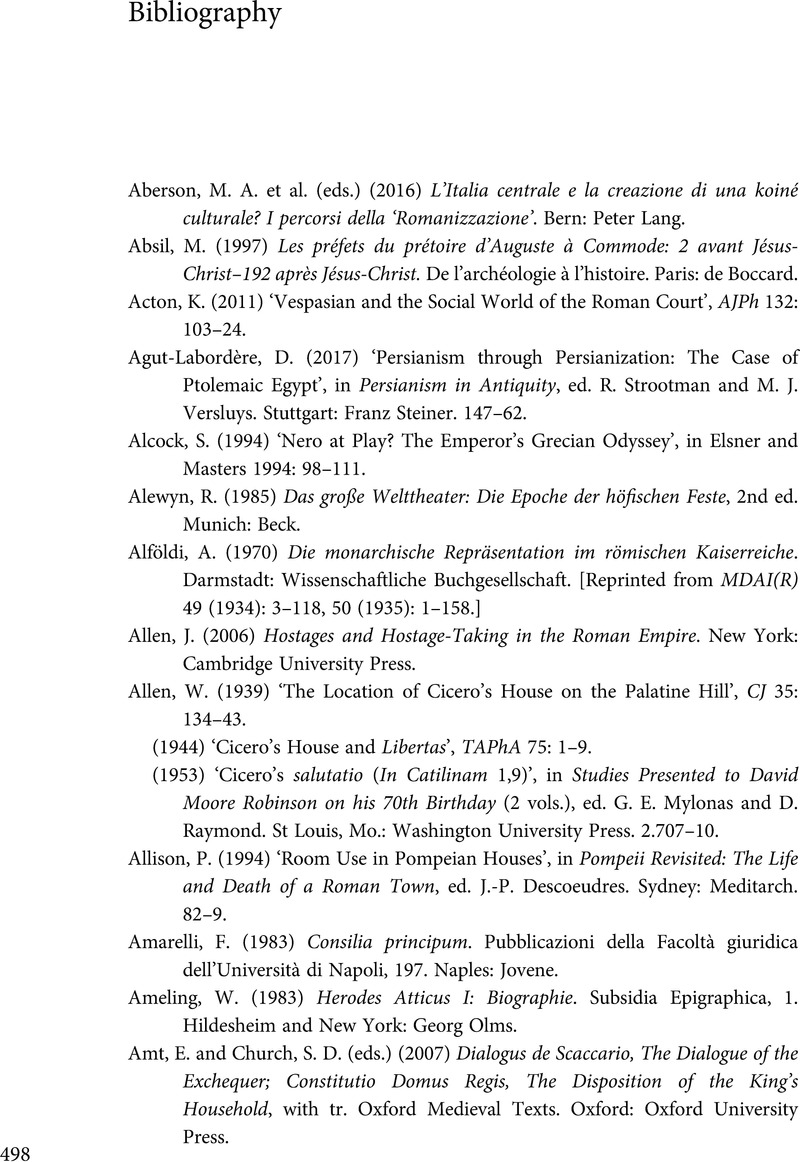Book contents
- The Roman Emperor and His Court c. 30 BC–c. AD 300
- The Roman Emperor and His Court c. 30 BC–c. AD 300
- Copyright page
- Dedication
- Contents
- Figures
- Tables
- Contributors
- Preface and Acknowledgements
- Abbreviations and Conventions
- 1 Introduction
- 2 Hellenistic Influences on Roman Court Culture
- 3 Republican Precursors
- 4 The Imperial Family
- 5 The Roman Aristocracy at Court
- 6 Administration, Finances, and the Court
- 7 Foreign Royals at the Imperial Court
- 8 Domestic Servants in the Imperial Court
- 9 The Imperial Palaces on the Palatine Hill: Architecture as a Reflection of Social Practices and Imperial Authority
- 10 Imperial Villas
- 11 Imperial Journeys
- 12 The Court and Ceremonial
- 13 Dining and Hunting as Courtly Activities in the Roman Empire
- 14 Sexuality and the Court
- 15 Violence and Security at Court
- 16 Religion and Divination at Court
- 17 Performance and Performers at Court
- 18 Literary Patronage and the Roman Imperial Court from Augustus to the Severan Dynasty
- 19 Dress, Adornment, and Self-Presentation
- 20 Epilogue: Continuity and Change at the Roman Imperial Court
- Bibliography
- Index of Personal Names
- General Index
- References
Bibliography
Published online by Cambridge University Press: 29 September 2022
- The Roman Emperor and His Court c. 30 BC–c. AD 300
- The Roman Emperor and His Court c. 30 BC–c. AD 300
- Copyright page
- Dedication
- Contents
- Figures
- Tables
- Contributors
- Preface and Acknowledgements
- Abbreviations and Conventions
- 1 Introduction
- 2 Hellenistic Influences on Roman Court Culture
- 3 Republican Precursors
- 4 The Imperial Family
- 5 The Roman Aristocracy at Court
- 6 Administration, Finances, and the Court
- 7 Foreign Royals at the Imperial Court
- 8 Domestic Servants in the Imperial Court
- 9 The Imperial Palaces on the Palatine Hill: Architecture as a Reflection of Social Practices and Imperial Authority
- 10 Imperial Villas
- 11 Imperial Journeys
- 12 The Court and Ceremonial
- 13 Dining and Hunting as Courtly Activities in the Roman Empire
- 14 Sexuality and the Court
- 15 Violence and Security at Court
- 16 Religion and Divination at Court
- 17 Performance and Performers at Court
- 18 Literary Patronage and the Roman Imperial Court from Augustus to the Severan Dynasty
- 19 Dress, Adornment, and Self-Presentation
- 20 Epilogue: Continuity and Change at the Roman Imperial Court
- Bibliography
- Index of Personal Names
- General Index
- References
Summary

- Type
- Chapter
- Information
- The Roman Emperor and his Court c. 30 BC–c. AD 300 , pp. 498 - 558Publisher: Cambridge University PressPrint publication year: 2022



